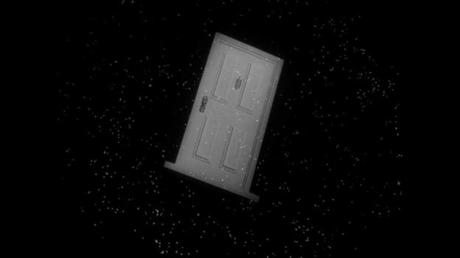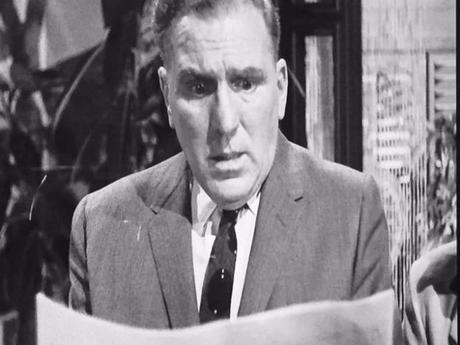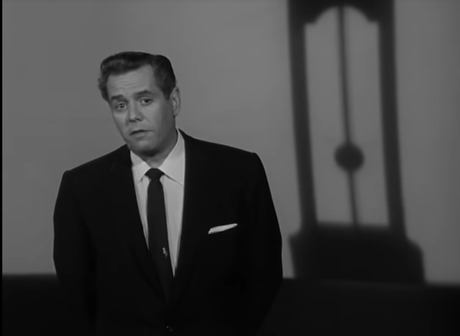Without Lucille Ball, there would be no Star Trek. As head of the production company Desilu, she's the one who agreed to finance the expensive pilot, "The Cage." Sure, she initially saw the title Star Trek and thought Gene Roddenberry intended to make a series about a group of traveling USO performers, but she gave him the money to make his show. When CBS rejected it and made the nearly unprecedented request for a second pilot, the Desilu board wanted to cut their losses, walk away from the project. Ball overruled them and agreed to finance the second pilot, "Where No Man Has Gone Before." The rest is history.
This rather infamous story is already known by most sci-fi nerds. If not, sites seem to run stories about it every couple of years as a reminder. Lesser known, however, is the role Lucille's first husband Desi Arnaz - and the "Desi" in "Desilu" - played in the creation of one of TV's all-time greatest sci-fi show, The Twilight Zone, a half-decade earlier.
Without him: We never get this:But this isn't quite as simple as Desi overruling a board of directors and giving Rod Serling his money. In fact, Desi's primary role here was backing a producer he trusted. He should have - he's the one who hired the guy in the first place.
Meet Bert Granet.Writer, producer, and hard-nosed realist, Granet transitioned to TV after working on movies like Berlin Express and The Marrying Kind. By 1958, he was the head producer of Westinghouse Desilu Playhouse, an anthology series on CBS which aired standalone dramas every three weeks out of four and a sitcom scenario starring Lucille Ball and Desi Arnaz in the fourth week.That last part is what everyone cared about. It's certainly why Westinghouse contributed millions as sponsor.

I Love Lucy had ended a year earlier, and the famous couple were in the midst of turning their company Desilu into a TV powerhouse. In the years to come, they would divorce but still produce both The Andy Griffith Show and The Dick Van Dyke Show, and after Ball bought Arnaz out she produced Star Trek. However, in 1958 they were still technically married, transitioning out of their famous TV parts and into full-time behind the scenes roles.

Rod Serling, ironically, was actually transitioning toward going on camera for the first time, as host of The Twilight Zone. After a creatively frustrating, but financially fruitful decade penning scripts for live anthology dramas, he'd grown tired of the constant interference from corporate sponsors. Whenever he dared to actually write something with any relevance to current events, the network would neuter it to the point of incoherence.
For example, here, in his own words, is what became of his second attempt to write a script about the Emmett Till case:
"By the time A Town Has Turned to Dust went before the cameras, my script had turned to dust. Till became, as Times noted, a romantic Mexican who loved the storekeeper's wife, but 'only with his eyes.' My sheriff couldn't commit suicide because one of our sponsors was an insurance firm and they claimed suicide often leads to complications in policy claims. The lynch victim was called Clemson, but we couldn't use this cause South Carolina had an all-white college by that name. The setting was moved to the Southwest in the 1870s. The phrase 'Twenty men in hoods' became 'Twenty men in homemade masks.' They chopped it up like a collection of butchers at work on a steer."
Add to that an 18-month span in which eight of the live anthology shows he'd written for went off the air and Serling recognized the need for a life raft. Before being made obsolete, it was time to adjust to the changing TV landscape while also hopefully outsmarting the sponsors. As countless authors and filmmakers have learned ever since, it was time to use metaphor to deliver social commentary.
His next stop: The Twilight Zone.
Don't go opening that door just yet. There was still the little matter of convincing the idiot network execs.
Serling's pilot script - "The Time Element," which he adapted from an old radio drama he wrote right out of college - sold to CBS where it seemed to go straight into a desk drawer. No doubt, it collected test with the countless other worthwhile projects networks pass on for obtuse reasons. If not for Granet, that's probably where it would have stayed.
However, Granet's strategy for building up Westinghouse Desilu Playhouse was to attract as many big name actors, writers, and directors as possible. As a three-time Emmy winner, Serling certainly qualified, and through mutual friend Robert Parish, a film director who later helm some of Twilight Zone 's best episodes, a meeting was set up to discuss story ideas.
"Rod remembered that he had once sold something to CBS, and CBS wasn't doing anything with it," Granet told The Twilight Zone Companion author Marc Scott Zicree. "So, using great persuasion, I found out what it was, got to CBS, and bought it for what was a lot of money at the time-ten thousand dollars."
"The Time Element" wasn't exactly a traditional drama for Westinghouse Desilu Playhouse. The logline: A man travels back in time to Hawaii only to discover it's the day before the Pearl Harbor attack. Naturally, he tries to warn everyone of their impending doom, but nobody believes him. Still, Granet put into the production schedule for the first season.
 Westinghouse has some notes.
Westinghouse has some notes. More accurately, the advertising agency representing Westinghouse had some notes. Well, just the one, really. As Granet recalled, "I got a call from New York: 'Absolutely, flatly no.' They didn't want any unfinished stories. They wanted neat bows at the end where each story wrapped up, unlike Twilight Zone stories which gave you many outs, many possibilities using imagination."
Granet, to his immense credit, refused to back down. The episode was still happening. Westinghouse again disagreed. "They flew out about four important vice-presidents to tell me why not. And I must say, at this point all it would have meant was swallowing ten thousand dollars in not doing it. But [Desi] Arnaz backed me up. "
When faced with giving in to advertiser demands or backing the creative instincts of the man he hired to do the job, Arnaz chose the latter. If he'd been just a little less courageous, that likely would have been the last the world heard of "The Time Element." However, with both Arnaz and Granet backing it Westinghouse ultimately withdrew its categorial refusals, replacing them instead with some conditions:
Westinghouse has some more notes."They said if we did it I had to make a blood promise that I would never do that kind of story again," Granet recalled. Also, the main character in the script could no longer be shown trying to warn the Army since Westinghouse had government contracts and didn't exactly see the upside in potentially upsetting the Pentagon.
Serling took the note, did his rewrite, and his Twilight Zone pilot finally went before cameras. Except now it was just a Westinghouse Desilu Playhouse episode. There was no promise of anything beyond that. Still, at least he got his story produced.
"Why wouldn't anyone listen to me?"
In the final version of "The Time Element," William Bendix plays Pete Jenson, a small-time bookie suffering from recurring dreams in which he is in Hawaii right before Pearl Harbor. He seeks help from a psychiatrist named Gillespie, who of course believes these to be the products of a fantastical imagination. However, when Bendix falls asleep in the psychiatrist's office he travels back in time to the attack itself and ends up dying.
Back in the present, Dr. Gillespie awakes from his own nap. Bendix is not there nor does Gillespie remember him. However, when the good doctor goes to a nearby bar he sees a picture of an old bartender on the wall. It's Bendix! When he asks about this vaguely familiar-looking man, he's informed the poor fella died at Pearl Harbor!
Honestly, it's not Serling's best work. It's a rather pedestrian predecessor to the greatness which became Twilight Zone. Still, if this had been produced as a Twilight Zone pilot the episode clearly would have ended with Serling re-appearing as host with some pithy sum-up of the evening's events. Instead, Arnaz served as the episode's host, and those who tuned into Westinghouse Desilu Playhouse got this at the end:
The epilogue
As one final concession to Westinghouse, Arnaz actually closed out the episode with the following on-screen musing: "We wonder if Pete Jenson did go back in time or if he ever existed. My personal answer is that the doctor has seen Jenson's picture at the bar sometime before and had a dream. Any of you out there have any other answers? Let me know."
Arnaz encouraging the audience to write-in with their opinions worked. Within days, Desilu Playhouse received six thousand letters about "Time Element," more than any other episode that year. On top of that, the reviews were overwhelmingly positive, with the New York Times referring to "The Time Element" as "consistently arresting."
CBS had shelved it; Desilu Playhouse gave them a proof-of-concept showing how wrong they were. Due to that success, CBS came back to Serling with an offer to make this work as a TV series. One small problem: he didn't have a pilot script anymore.
That's great, but I don't have a pilot script anymore!Well, that'd be a problem for any normal person. Rod Serling wasn't normal. His ability to churn out quality scripts in record time was already legendary by that point. He quickly gave CBS a new pilot script, this time a kind of Logan's Run precursor story about a future society which forcefully euthanizes the old. He wrote it after his own mother died. When CBS rejected it for being too morbid, he came back a couple of days later with "Where is Everybody?", a more straightforward story about an amnesiac astronaut who wakes up to an Earth completely devoid of other people. That then became the first episode of The Twilight Zone.
Granet, meanwhile, continued his run with Desilu Playhouse and struck gold with another episode which served as a backdoor pilot for a TV series, this time The Untouchables. He moved on to that when Desilu was canceled after its second season.
The twist ending. Kind of.The final ironic twist - and since this is an article about Twilight Zone there has to be a twist - is this: remember when Westinghouse demanded Granet make "a blood promise that I would never do that kind of story again"? Well, it's not like he had to honor that for shows which Westinghouse didn't sponsor. So, he had no problem working as a producer on Twilight Zone 's final two seasons.
It was only fitting he be there for the show's end. Without him - and Desi Arnaz - it never would have had a beginning.
As of this writing, you can stream the entire "Time Element" episode of Desilu Playhouse on YouTube.
Sources: Serling: The Rise and Twilight of Television's Last Angry Man by Gordon Sander, The Twilight Zone Companion By Marc Scott Zicree

Grew up obsessing over movies and TV shows. Worked in a video store. Minored in film at college because my college didn't offer a film major. Worked in academia for a while. Have been freelance writing and running this blog since 2013. View all posts by Kelly Konda

